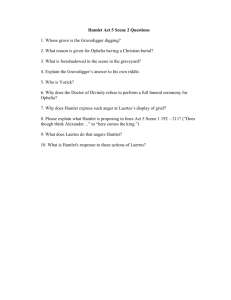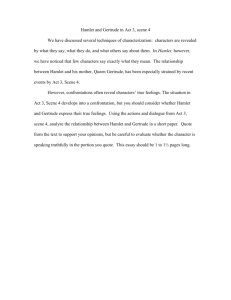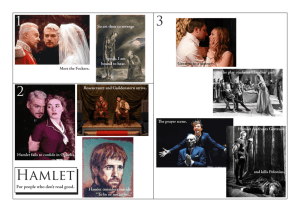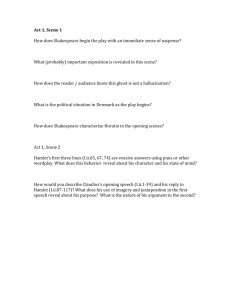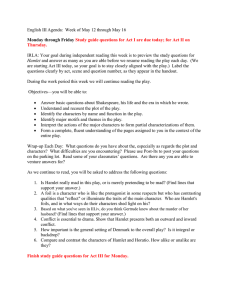Hamlet - Cloudfront.net
advertisement
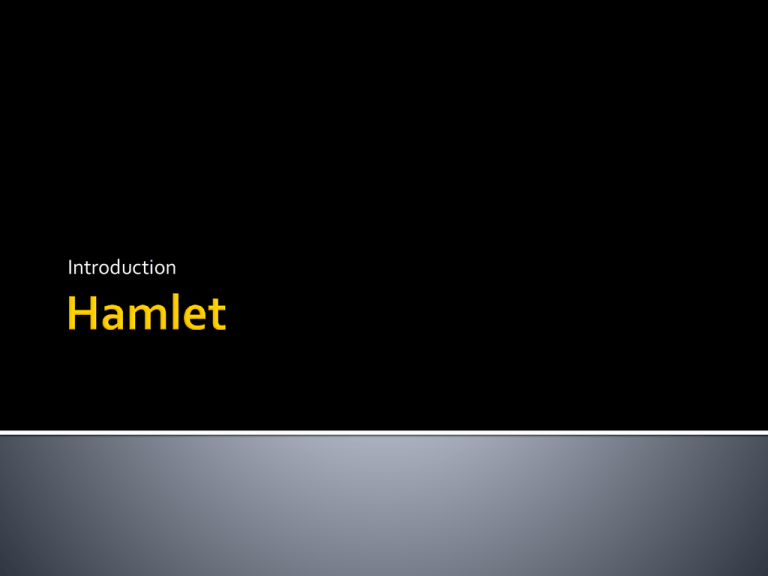
Introduction 1. Humans had potential for development. 2. The idea of medieval Christianity, that this world is a preparation for eternal life, was questioned. Instead, people began to see everyday life as meaningful and an opportunity for noble activity. 3. This was a time for heroes. The ideal Elizabethan man was a talented courtier, adventurer, fencer, poet, and conversationalist. He was a witty and eloquent gentleman who examined his own nature and the causes of his actions. 4. Marriages were arranged, usually for wealth. 5. Women had a lower social status than men. 6. People were concerned over the order of things. They felt there was “a great chain of being.” This concept originated with Plato and expressed the idea that there is a proper order within all things, and among all things, based on complexity, from the tiniest grains of sand to heaven and God. When everything was in its proper position, there was harmony. When the order was broken, everything was upset and everyone suffered. 7. People felt that their rulers were God’s agents. To kill a King was a heinous crime; the heavens would show ominous signs when such evil was present. formal versus informal forms of address Modern English has lost this division, but in the Renaissance, there were two forms of second-person address—the formal and the informal. You was the formal form of address, and thou was the familiar. , the formal form of address was used when an inferior was talking to a superior, when two business colleagues who were not close friends were speaking, or when the speaker wanted to maintain a distance. The informal was more intimate, to be used among friends, family members, and persons to whom the speaker wanted to imply closeness. Claudius address Laertes, inviting him to present his petition to return to France: And now, Laertes, what’s the news with you? You told us of some suit. What is’t, Laertes? You cannot speak of reason to the Dane, And lose your voice. What wouldst thou beg, Laertes, That shall not be my offer, not thy asking? (21) As the King shifts from the formal to the familiar, a reader can almost see him rise from the throne, step down from the dais, and place a warm and friendly arm around Laertes’ shoulders. KING CLAUDIUS But now, my cousin Hamlet, and my son,-…How is it that the clouds still hang on you? QUEEN GERTRUDE Good Hamlet, cast thy nighted color off, And let thine eye look like a friend on Denmark. (22) Gertrude, of course, uses the familiar thou when addressing her son, but Claudius, though he calls Hamlet “son,” never addresses him in the familiar. Note this exchange between Hamlet and his mother in Act III, Scene iv: QUEEN GERTRUDE Hamlet, thou hast thy father much offended HAMLET Mother, you have my father much offended. (80) Throughout the play, Gertrude uses both the formal and familiar while addressing her son. Hamlet stays always in the formal, implying—certainly—his status as her son, but also clearly establishing the distance he feels from her. Be aware of how the various characters address one another and in what contexts they use what form of address. • The Garden—Serpent: In Act I, scene v, we learn, fi rst of all, that the belief is that Hamlet’s father died after having been stung by a snake while napping in his garden. Then the Ghost tells Hamlet, “The serpent that did sting thy father’s life / Now wears his crown.” (35) In his soliloquy in Act I, scene ii, Hamlet says that the world is “an unweeded garden/ That grows to seed” (p 24). This Garden Motif is echoed with Ophelia in Act V. Hamlet’s desire for (and concept of) Death: Act I, Scene ii: O, that this too too sullied (solid) flesh would melt, Thaw and resolve itself into a dew, Or that the Everlasting had not fi x’d His canon ‘gainst self-slaughter! (23-24) Continues throughout the book in every act Act I, Scene ii: ‘Tis an unweeded garden That grows to seed; things rank and gross in nature Possess it merely. (24) Act I, Scene iv: Something is rotten in the state of Denmark. (34) Act I, Scene v: [poured] …in the porches of my ears did pour The leperous distilment; whose effect …courses through The natural gates and alleys of the body, And with a sudden vigour doth … curd … The thin and wholesome blood … And a most instant tetter bark’d about, Most lazar-like, with vile and loathsome crust, All my smooth body. (36) Again, seen throughout the book Metafiction is a kind of fiction that comments on the very devices of fiction it employs. It usually involves irony and is selfreflective. Metadrama is similar—drama that calls attention to itself as a play or has occasion to comment on its own actions and devices. This is most apparent when the Players arrive (Act II, Scene ii). A SOLILOQUY is a monologue. The character is alone onstage. It is a DEVICE the playwright uses to give the audience insight into the character’s thoughts and emotions. Shakespeare uses soliloquies to allow the reader the true cause of Hamlet’s melancholy and to witness Hamlet’s understanding of death and his desire to die. The ASIDE is another DEVICE used by the playwright to give the audience insight into the character. Here the character is speaking either to himself or directly to the audience. There are other characters onstage who, by convention, do not hear the aside. • An ALLUSION is an indirect reference to another event, person or work with which the writer assumes the reader is familiar. Shakespeare uses ALLUSIONS as techniques for establishing character, building theme, and setting mood. In Hamlet, there are allusions to Greek and Roman mythology, Roman history, and the Bible. Use of THE SUPERNATURAL is another DEVICE. MADNESS, either real or pretended, was another popular DEVICE in Elizabethan drama. One also cannot discuss Elizabethan tragedy without a discussion of the TRAGIC HERO. There can be no drama at all without CONFLICT. In Hamlet, the primary conflict is INTERNAL between Hamlet’s sense of duty to avenge his father’s murder and his inability to take action. Front Cover list the “major/minor characters”, label static, round, flat, etc… with page references 1 literary device for each ACT (total of 5-different devices) w/ explanations and page numbers Inside the book a brief summary of the key points within each ACT. Total of 5. Back Cover 1. list the themes/motifs with page references and examples for each ACT. (I each per act-5 themes/5motifs) 2. list the Soliloquys for each ACT w/ explanations and page numbers. Be sure to include which character is speaking.
